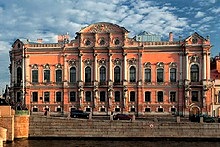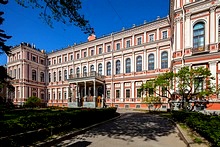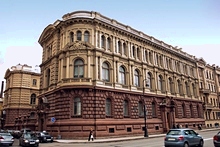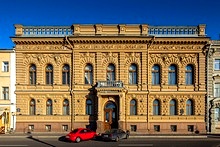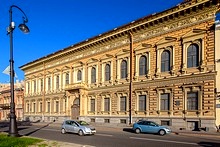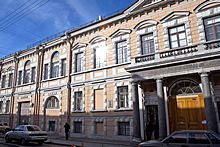Palaces of St. Petersburg
Many of Russia's noble families were reluctant to move their residences to Peter the Great's new northern capital, and the Tsar was forced to issue a decree banning building in stone elsewhere in the country to ensure that the nation's wealth and construction skills were transferred to St. Petersburg. Nonetheless, only a century later, St. Petersburg could boast a huge number of palaces, including some of the grandest residences not just in Russia, but in the whole of Europe. Taking their cue from the incomparable splendours of the Winter Palace, St. Petersburg's elite built on the grand scale, adopting architectural styles from rococo to Russian Revival to create monumentally impressive buildings with equally rich and varied interiors.
While many of St. Petersburg's palaces suffered cruelly during the October Revolution and the Siege of Leningrad, the period since has seen a massive effort to restore them to their former glories, and many are now open to the public, either simply as stately homes or as museums of art and history, or at least as venues for occasional concerts and other events.
St. Petersburg's finest and most famous palace, the Winter Palace is one of the greatest royal residences of the world, the home of the Romanov Emperors for two hundred years, and the main building of the world-famous Hermitage Museum.
Home to the State Russian Museum, the Mikhailovskiy Palace was originally built for Grand Duke Mikhail Pavlovich, brother of Alexander I, and is one of the finest works of Carlo Rossi, St. Petersburg's master of neoclassical architecture.
Among the earliest neoclassical buildings in St. Petersburg, the Marble Palace was originally built - using 32 different types of marble - for Grigory Orlov, favourite of Catherine the Great, before becoming a residence for junior members of the Romanov family.
Also now part of the State Russian Museum, the Mikhailovskiy Castle was the pet project of Emperor Paul I, and its unusual architecture reflects his particular tastes. The site of his assassination only 40 days after its completion, it was subsequently used as a college of military engineering.
Built in the 1750s by Francesco Bartolomeo Rastrelli, chief architect of the Winter Palace, for the influential Stroganov family, the Stroganov Palace is one of the most striking buildings on Nevsky Prospekt, and as part of the Russian Museum is now being fully restored internally.
Located next to Anchikov Bridge on Nevsky Prospekt, the Beloselskiy-Belozerskiy Palace is a St. Petersburg landmark thanks to its unmistakable deep pink facades and intricate neo-baroque. Currently shared by numerous institutions, it is occasionally open for guided tours.
Next to the famous bridge of the same name across the Fontanka River, the Anichkov Palace is one of the oldest buildings on Nevsky Prospekt. Now home to a variety of educational organizations, it was once the home to several heirs to the Romanov throne.
The oldest palace in St. Petersburg, Peter the Great's Summer Palace in the beautiful Summer Garden is an elegant baroque mansion that, under the auspices of the State Russian Museum, has charming interiors evoking Peter's domestic life.
Also known as 'the Fountain House', this beautiful baroque building on the Fontanka River Embankment was the home to generations of one of Russia's most prominent families, and became a centre of culture in St. Petersburg. It now houses a museum of musical instruments.
Notorious as the site of the assassination of Grigory Rasputin, this elegant baroque palace dates from 1770, and was long the main St. Petersburg home of the wealthy Yusupov family. It is open as a museum, and boasts unusually well preserved interiors.
Built for Prince Grigory Potemkin, favourite of Catherine the Great, this grand Palladian palace in the centre of St. Petersburg set the benchmark for aristocratic residences in the city, and now houses the Interparliamentary Assembly of the Commonwealth of Independent States (CIS).
An immense Empire-style edifice opposite St. Isaac's Cathedral in the very centre of St. Petersburg, the Mariinskiy Palace was a wedding present for Grand Duchess Maria Nikolaevna, and is now the site of St. Petersburg's Legislative Assembly.
Also known as the "Palace of Labour", thanks to its current employment as a trade union headquarters, the Nikolaevskiy Palace is a vast neoclassical palace built in the mid-19th century for one of the sons of Emperor Nicholas I.
One of the oldest palaces in St. Petersburg, the Vorontsov Palace is a beautiful baroque building noticeable for its prominent position opposite Gostiny Dvor on Sadovaya Ulitsa, which has been used since the early 19th century as an elite military college.
This beautiful mid-19th century palace overlooking the Neva River on the Palace Embankment was built by court architect Andrey Stakenschneider for Grand Duke Mikhail Nikolaevich, son of Emperor Nicholas I.
One of the last palaces in St. Petersburg to be built for the Imperial family, this elegant but comparatively compact building close to the Winter Palace has superbly preserved interiors in an eclectic range of styles.
Maximilian Messmacher, the great court architect and interior designer of the late 19th century, built this elegant Renaissance Revival palace for the grandson of Emperor Nicholas I who, due to the fallout from his controversial marriage, was never able to take up residence.
Alexey Alexandrovich, brother of Emperor Alexander III, spend most of his life serving in the Russian Navy, and retired to this charming chateau-like palace built by Maximilian Messmacher close to St. Petersburg's main shipyards.
Built for a soldier nephew of Alexander II, this elegant neoclassical revival mansion on the Petrovskaya Embankment dates from 1913 and was the last Grand Ducal Palace erected in St. Petersburg.
With its distinctive Renaissance Revival facades of pink marble and gray granite, this extremely attractive small palace briefly belonged to Grand Duke Nikolay Konstantinovich, whose scandalous affair with an American dancer caused him to be exiled from St. Petersburg.
Alexander Mikhailovich, grandson of Nicholas I, was one of the most interesting junior members of the Romanov family, a talented writer as well as an admiral in the Russian Navy. His modest palace near New Holland is now home to St. Petersburg's main sports academy.
This elegant palace in the style of the Florentine Renaissance was once the home of the immensely wealthy railway magnate Paul von Derviz, before being bought for the last grand duke of the Romanov dynasty.
Bought for the youngest daughter of Emperor Alexander III in 1896, this distinctive red mansion on Ulitsa Tchaikovskogo was built in stages over a century. Its impressive restored interiors can be viewed on guided tours.
A beautiful example of Art Nouveau architecture, this severely symmetrical building on the English Embankment was the St. Petersburg home of Nicholas II's brother, Mikhail Alexandrovich.
The home of Imperial Russia's greatest financier, the Baron von Stieglitz Mansion on the English Embankment was later bought by the treasury as the palace of Alexander II's youngest son. The building has recently been acquired by St. Petersburg State University.
This large palace on the Fontanka River is architecturally rather plain, but belonged to two of the most prominent families in Russian history - the Naryshkins and the Shuvalovs - and was famous for the grand balls held here in the early 19th century.
Now home to the Herzen Pedagogical University, this ornate palace on the Griboedov Canal was originally built for Cossack Hetman Kirill Razumovsky in the 1760s, and has been occupied by several educational institutions since.
The St. Petersburg home of Alexander Bezborodko, one of the most powerful men in Russia under Catherine the Great, this elegant neoclassical palace by Giacomo Quarenghi later became part of the postal service headquarters, and now houses the Museum of Communications.
A charming summer residence on Yelagin Island in the north of St. Petersburg, the Yelagin Palace was built by Carlo Rossi for Empress Maria Fyodorovna, mother of Alexander I, and is now home to a museum of palace interiors.
One of St. Petersburg's least known Imperial residences, Kamennoostrovskiy Palace is a grand neoclassical palace in the north-west of the city that was the favourite home of Alexander I, and is set to become the official residence of the Governor of St. Petersburg.
Once a resting post for the Imperial court on the way to Tsarskoye Selo, Chesmenskiy Palace is an interesting architectural oddity that has sadly long lost its original splendor, and is overshadowed by its charming church.






